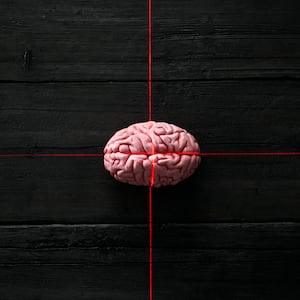Despite how easy movies like Eternal Sunshine of the Spotless Mind, Men in Black, and Total Recall make it seem, memory manipulation or erasure in humans is still a distant dream in the real world—and for good reason. While many researchers agree it could revolutionize things like PTSD and other mental-health treatment—not to mention delete memories of embarrassing and cringe moments in our lives—they are wary of tampering too much. That's because even our most unpleasant memories can serve important purposes.
“Our memories are what make us who we are,” Sheena Josselyn, a memory and learning researcher at the Josselyn Frankland Lab at the Hospital for Sick Children in Toronto, Canada, told The Daily Beast. “And when we start messing with them, without there being a real imperative to do so, I think that we can really mess things up at the societal level. So I think it's really important that we do these sorts of interventions very sparingly.”
Although we understand very little about how the brain works, research undertaken in the last decade is slowly illuminating the path to understanding how memories form, and how they are stored and retrieved. Studies show it is possible to erase specific memories, create false memories, or reduce the trauma and recall associated with a distressing memory—at least in snails and rodents. While there are currently no drugs or treatments that can achieve memory manipulation in humans, these findings have laid the foundation for future memory manipulation.
In 2014, MIT researchers Steve Ramirez and Xu Liu, were able to manipulate a mouse into thinking it had received a shock inside a triangular metal box—effectively inserting an entirely false memory into the mouse’s brain. The researchers put the mice (which had been genetically engineered to render the target area in their brains sensitive to light) in a triangular box, which activated specific neurons in their brains.

Caption:MIT neuroscientists identified the cells (highlighted in red) where memory traces are stored in the mouse hippocampus.
Steve Ramirez and Xu Liu / MITThey then put the mice in a square box, and administered a foot shock while shining a laser on the neurons associated with the triangular box. This was done by first surgically implanting thin laser filaments into the mice’s brains and then activating the laser at the exact moment the shock was administered.
The mice immediately started to display fearful behavior in the triangular box—indicating that they remembered experiencing a shock in it, even though that had never happened. Ramirez and Liu’s findings opened the door to newer research and breakthroughs in memory implantation and erasure.
More recently, in 2017, researchers at Columbia University Irving Medical Center and McGill University were able to show that it may be possible to effectively eliminate the triggers that bring on distressing recall of a traumatic memory, in some cases. Samuel Schacher, co-author of the study, explained in an interview with Columbia University that a victim who had been mugged in a dark alley would rightly be scared of dark alleys after the incident. But they might also feel fear and distress when they see something that happened to be in the vicinity during the attack like, for instance, a mailbox.
The fear induced by the sight of the mailbox is called a non-associative memory. People with trauma-associated disorders such as PTSD may re-experience the fear and distress they felt during the traumatic incident upon coming across sights, sounds, or smells associated with the trauma, due to the formation of these non-associative memories. This obviously impacts their quality of life, and is what memory researchers are trying to treat.
Part of the reason this is so difficult is that traumatic memories tend to take hold of the brain more firmly than non-distressing memories. “A critical function of the nervous system is to remember experiences, especially when they are relevant to one’s survival or reproduction,” Schacher, co-author of the Columbia University study, and former professor of neuroscience in the Department of Psychiatry at CUIMC, told The Daily Beast. “So threatening events, in particular, are stored in the brain for longer.”
He added, “At one point in your life, you may have realized that if you touch fire, you will burn yourself, and it is permanently stored in your brain.”
Schacher’s research seeks to reduce the emotional impact of a traumatic memory while keeping the actual memory of the trauma intact. In a study he co-authored published in the journal Current Biology in 2017, his team was able to selectively erase different memories stored in the same neuron in snails.
Similarly, Richard Huganir, director of the department of neuroscience at the Johns Hopkins University School of Medicine, was able to show in 2010, that it was possible to reduce the fear associated with a traumatic memory in mice, by removing certain proteins (calcium-permeable AMPARs) from the region of the brain encoding emotional memory.

Two sensory neurons plated with a single motor neuron. Schacher and his team were able to selectively erase different memories stored in the same neuron in snails.
Samuel Schacher / Columbia UniversityHowever, no existing drugs are able to remove these proteins in such a targeted manner in humans. But if there were a way to do this, it would work better than methods involving exposure therapy—which involves confronting traumatic memories, thoughts or associations under the guidance of a therapist—that are prone to relapse. “Because it would truly erase the emotional content of the memory, therefore [patients] would not have relapses,” Huganir told The Daily Beast.
Along similar lines, Josselyn’s lab in Toronto studies how the brain encodes memory. They have successfully shown how it may be possible to erase fearful memories from the brains of mice, by killing a certain population of brain cells in a targeted way.
“We found cells that we thought were really important in a memory, and we killed this very small population of cells in a really targeted way in mice,” Josselyn told The Daily Beast. “And we found that the memory was essentially erased.”
Months or years after having suffered a traumatic experience, the memory of the trauma can continue to debilitate a person—often manifesting as PTSD. The disorder is characterized by episodes that bring back the suffering and distress of the original trauma, often triggered by the sight, sound, or something else associated with the trauma. These episodes can include nightmares, flashbacks, fear, severe anxiety, or panic attacks.
Erasing the association between a “trigger” and the trauma, or reducing the emotional impact of traumatic memories could offer people who live with the most severe forms of PTSD, or other trauma-induced disorders, some relief. Doing this in a targeted manner that attacks the distressing impact of the memory, while leaving the memory intact, can be incredibly helpful, and reduce many of the concerns related with memory erasure.
“In the case of someone suffering from [PTSD], you don’t want to erase the fact that they underwent some trauma,” Schacher said. “You don’t want to erase the memory itself.”
For instance, someone who has been abused may find themselves triggered by loud voices, or a perfume similar to something their abuser wore. Schacher’s research shows that it may be possible to remove the association between the trigger (e.g. loud voices or perfume) and the trauma, while keeping the memory of the trauma intact so that they no longer cause distressing flashbacks.
Discovering a way to erase memories isn’t the only way this research could illuminate the way forward. Understanding how memories are formed, stored, and retrieved could also help people with memory dysfunction of the opposite kind like Alzheimer’s, dementia, or amnesia.
“I think there's two sides of the coin: too much memory or not enough memory,” Josselyn said. She pointed out that in the early stages of diseases like Alzheimer’s “there are memories, but people can't seem to find them.”
“So if we understand a little bit more about how memories are made, and how to retrieve them, maybe we can help unlock some of these forgotten memories in people with dementia,” she added.
Although memory manipulation is still far from being reality, ethical and medical concerns abound.
Would we even be ourselves, with enhanced or suppressed memories? There’s also a chance it could actually cause issues like dissociative identity disorder—a response to severe trauma that causes patients to dissociate and shut off from the trauma—or cause an increase in anxiety and panic attacks in the people who have their traumatic memories suppressed.
There are also concerns about what might happen if this sort of technology fell into the wrong hands. How might a powerful government or military organization use the ability to erase or even enhance memories? All of a sudden, the thought of a Men in Black-style organization zapping away memories to keep things secret doesn’t seem far-fetched at all.
Moreover, there could also be issues surrounding disparity: Who exactly gets to enhance or erase their memories and who doesn’t? If it’s only available to the wealthy and powerful, that means that they are the only ones who can benefit from it. There may very well one day be a class system partially based on access to memory technology.
“If we do get general cognitive enhancers that everybody can take, there isn’t going to be equal access to those drugs,” Huganir said. “They’re gonna cost money and so of course they won’t be very equitable. They won’t be available to everybody and there’s also potential for abuse.”
Although understanding how memories work is critical to treating memory disorders or ease trauma, researchers agree that these treatments must be reserved for those suffering from severe trauma, PTSD, or other memory issues.
Tempting as it may be to rid ourselves of the memory of an embarrassing drunk karaoke performance, or rid our minds of memories of our exes, using memory manipulation in those ways could be incredibly damaging otherwise. And science is still a long way off from being able to do this accurately or safety.
“I think this type of treatment would only be for incredibly invasive, troubling memories—not just sort of our everyday ‘Yikes, that was horrible!’ sort of memory,” Josselyn said.
Although we’re still a long way off from being able to press a button (or more realistically, administer a drug) and reliably wipe a specific memory from a person’s brain, every new finding takes us a step further, shedding light on how memory functions, how it malfunctions, and what to do when that happens.









